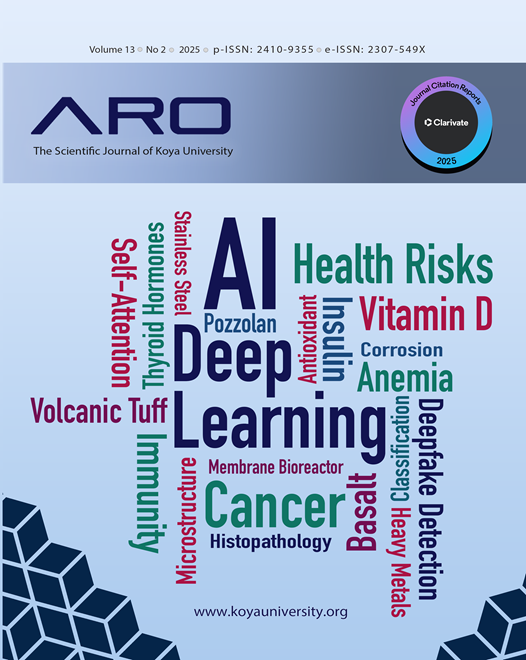Synthesis, Characterization, and Antioxidant Studies of Novel Cu(II) and Ni(II) Homo Binuclear Complexes with N,N’-bis(Benzamidothiocarbonyl) Hydrazine Ligand Derivatives
DOI:
https://doi.org/10.14500/aro.12284Keywords:
Antioxidant,, bis(thiourea)hydrazine ligands, Cu(II) and Ni(II) coordination, Homo binuclear complexes, Square planar geometryAbstract
This study presents the synthesis, spectral characterization, and antioxidant evaluation of Cu(II) and Ni(II) homo binuclear complexes derived from three bis(thiourea)hydrazine ligands: N, N′-bis(benzamidothiocarbonyl)hydrazine (L1), N, N′-bis(o-chlorobenzamidothiocarbonyl)-hydrazine (L2), and N, N′-bis(p-methylbenzamidothiocarbonyl)hydrazine (L3). The ligands were synthesized via condensation reactions and characterized using CHNS elemental analysis, FT-IR, UV-Vis, and ¹H NMR and ¹³C NMR spectroscopy. The metal complexes were prepared in a 2:1 metal-to-ligand molar ratio and characterized by melting point determination, magnetic susceptibility, molar conductivity, and spectral techniques. IR data confirmed coordination through the thiocarbonyl sulfur and amide oxygen atoms, forming neutral bidentate complexes. Magnetic moment values and electronic spectra were consistent with square planar geometries for both Cu(II) and Ni(II) complexes. Molar conductance measurements indicated non-electrolytic behavior in DMF. Antioxidant activity was assessed via the DPPH radical scavenging assay, revealing that the metal complexes exhibited enhanced radical scavenging capacity compared to the free ligands, likely due to increased delocalization and metal ion involvement in electron transfer. These findings highlight the potential of bis(thiourea)hydrazine-based metal complexes as antioxidant agents.
Downloads
References
Ajayeoba, T., Akinyele, O., and Oluwole, A., 2017. Synthesis, characterisation and antimicrobial studies of mixed nickel (II) and copper (II) complexes of aroylhydrazones with 2, 21-bipyridine and 1, 10-phenanthroline. Ife Journal of Science, 19, pp.119-132. DOI: https://doi.org/10.4314/ijs.v19i1.12
AL-Amiery, A.A., Kadhum, A.A.H., and Mohamad, A.B., 2012. Antifungal and antioxidant activities of pyrrolidone thiosemicarbazone complexes. Bioinorganic Chemistry and Applications, 2012, pp.795812. DOI: https://doi.org/10.1155/2012/795812
Ariffin, A., Rahman, N.A., Yehye, W.A., Alhadi, A.A., and Kadir, F.A., 2014. PASS-assisted design, synthesis and antioxidant evaluation of new butylated hydroxytoluene derivatives. European Journal of Medicinal Chemistry, 87, pp.564-577. DOI: https://doi.org/10.1016/j.ejmech.2014.10.001
Arslan, H., Duran, N., Borekci, G., Koray Ozer, C., and Akbay, C., 2009. Antimicrobial activity of some thiourea derivatives and their nickel and copper complexes. Molecules, 14, pp.519-527. DOI: https://doi.org/10.3390/molecules14010519
Binzet, G.N., Arslan, H., and Külcü, N., 2007. Synthesis and thermal behaviour of Co (II), Ni (II) and Cu (II) complexes of N, N-di-n-propyl-N?-(2-chlorobenzoyl) thiourea. Asian Journal of Chemistry, 19, pp.5711-5717.
Claridge, S., Raeppel, F., Granger, M.C., Bernstein, N., Saavedra, O., Zhan, L., Llewellyn, D., Wahhab, A., Deziel, R., and Rahil, J., 2008. Discovery of a novel and potent series of thieno [3, 2-b] pyridine-based inhibitors of c-Met and VEGFR2 tyrosine kinases. Bioorganic and Medicinal Chemistry Letters, 18, pp.2793-2798. DOI: https://doi.org/10.1016/j.bmcl.2008.04.009
Coates, J., 2000. Interpretation of infrared spectra, a practical approach. Encyclopedia of Analytical Chemistry, 12, pp.10815-10837. DOI: https://doi.org/10.1002/9780470027318.a5606
Costa, C.M., and Gushikem, Y., 1984. Interaction of N-acylthiourea nickel (II) chelates with nitrogen bases in solution and in the solid state. Inorganica Chimica Acta, 90, pp.133-136. DOI: https://doi.org/10.1016/S0020-1693(00)88045-7
Dong, W.K., Yan, H.B., Chai, L.Q., Zhong-Wu, Z.W., and Zhao, C.Y., 2008. 3, 3’-Bis (4-nitrophenyl)-1, 1′-(p-phenylene) dithiourea dimethyl sulfoxide disolvate. Structure Reports, 64, pp.o1097-o1097. DOI: https://doi.org/10.1107/S160053680801430X
Douglass, I.B., and Dains, F., 1934, The preparation and hydrolysis of monoand disubstituted benzoylthioureas1. Journal of the American Chemical Society, 56, pp.1408-1409. DOI: https://doi.org/10.1021/ja01321a061
Ejidike, I.P., and Ajibade, P.A., 2015. Synthesis, characterization, antioxidant, and antibacterial studies of some metal (II) complexes of tetradentate schiff base ligand: (4E)‐4‐[(2‐{(E)‐[1‐(2, 4‐Dihydroxyphenyl) ethylidene] amino} ethyl) imino] pentan‐2‐one. Bioinorganic Chemistry and Applications, 2015, p.890734. DOI: https://doi.org/10.1155/2015/890734
Firdausiah, S., Hasbullah, S., and Yamin, B., 2018. Synthesis, structurale elucidation and antioxidant study of ortho-substituted N, N’-bis (benzamidothiocarbonyl) hydrazine derivatives. Journal of Physics: Conference Series, 2018, p.012010. DOI: https://doi.org/10.1088/1742-6596/979/1/012010
Hallale, O., Bourne, S.A., and Koch, K.R., 2005. Metallamacrocyclic complexes of Ni (II) with 3, 3, 3’, 3’-tetraalkyl-1, 1’-aroylbis (thioureas): Crystal and molecular structures of a 2: 2 metallamacrocycle and a pyridine adduct of the analogous 3: 3 complex. CrystEngComm, 7, pp.161-166. DOI: https://doi.org/10.1039/B419468C
Hollmann, K., Oppermann, A., Witte, M., Li, S., Amen, M., Flörke, U., Egold, H., Henkel, G., and Herres‐Pawlis, S., 2017. Copper (I) complexes with thiourea derivatives as ligands: Revealing secrets of their bonding scheme. European Journal of Inorganic Chemistry, 2017, pp.1266-1279.
Hu, J.H., Wang, L.C., Liu, H., and Wei, T.B., 2006. Biological activities studies and phase transfer catalysts promoting the one-pot synthesis of N-Aryl-N’-(4Ethyloxy Benzoyl)-thiourea derivatives. Phosphorus, Sulfur, and Silicon and the Related Elements, 181, pp.2691-2698. DOI: https://doi.org/10.1080/10426500600862878
Jamil, M., Zubair, M., Asim Farid, M., Rashid, U., Rasool, N., and Islam, S., 2013. Antibacterial, cytotoxic studies and characterization of some newly synthesized symmetrical N3, N3’‐bis (disubstituted) isophthalyl‐bis (thioureas) and Their Cu (II) and Ni (II) complexes. Journal of Chemistry, 2013, p.789743. DOI: https://doi.org/10.1155/2013/789743
Jumal, J., Yamin, B.M., Ahmad, M., and Heng, L.Y., 2012. Mercury ion-selective electrode with self-plasticizing poly (n-buthylacrylate) membrane based on 1, 2-Bis-(N’-benzoylthioureido) cyclohexane as ionophore. Apcbee Procedia, 3, pp.116-123. DOI: https://doi.org/10.1016/j.apcbee.2012.06.056
Kang, S.K., Cho, N.S., and Jeon, M.K., 2012. 1-Benzoyl-2-thiobiuret. Structure Reports, 68, pp.o395-o395. DOI: https://doi.org/10.1107/S1600536812000621
Ke, S.Y., and Xue, S.J., 2006. Synthesis and herbicidal activity of N-(of luorophenoxyacetyl) thioureas derivatives and related fused heterocyclic compounds. Arkivoc, 10, pp.63-68. DOI: https://doi.org/10.3998/ark.5550190.0007.a08
Lee, Y.H., Han, W.S., Lee, H.J., Ahn, S.M., and Hong, T.K., 2015. Lead (II) ion selective poly (aniline) solid contact electrode based on 1, 2-bis (N′benzoylthioureido) ethane,-propane and-butane ionophores. Journal of Analytical Chemistry, 70, pp.621-626. DOI: https://doi.org/10.1134/S1061934815050172
Lever, A.B.P., and Rice, S.A., 1969. Inorganic Electronic Spectroscopy. American Institute of Physics, United States. DOI: https://doi.org/10.1063/1.3035225
Manjula, S., Noolvi, N.M., Parihar, K.V., Reddy, S.M., Ramani, V., Gadad, A.K., Singh, G., Kutty, N.G., and Rao, C.M., 2009. Synthesis and antitumor activity of optically active thiourea and their 2-aminobenzothiazole derivatives: A novel class of anticancer agents. European Journal of Medicinal Chemistry, 44, pp.2923-2929. DOI: https://doi.org/10.1016/j.ejmech.2008.12.002
Mukerjee, A.K., and Ashare, R., 1991. Isothiocyanates in the chemistry of heterocycles. Chemical Reviews, 91, pp.1-24. DOI: https://doi.org/10.1021/cr00001a001
Nencki, M., 1873. Zur kenntniss des sulfoharnstoffs. Berichte der Deutschen Chemischen Gesellschaft, 6, pp.598-600. DOI: https://doi.org/10.1002/cber.187300601186
Nguyen, D.T., Le, T.H., and Bui, T.T.T., 2013. Antioxidant activities of thiosemicarbazones from substituted benzaldehydes and N-(tetra-O-acetylβ-D-galactopyranosyl) thiosemicarbazide. European Journal of Medicinal Chemistry, 60, pp.199-207. DOI: https://doi.org/10.1016/j.ejmech.2012.10.004
Odame, F., Hosten, E., Krause, J., Isaacs, M., Hoppe, H., Khanye, S.D., Sayed, Y., Frost, C., Lobb, K., and Tshentu, Z., 2020. Synthesis, characterization and biological activity of some dithiourea derivatives. Acta Chimica Slovenica, 67, pp.764-777. DOI: https://doi.org/10.17344/acsi.2019.5689
Ranise, A., Bondavalli, F., Bruno, O., Schenone, S., Donnoli, D., Parrillo, C., Cenicola, M., and Rossi, F., 1991. 1-Acyl-, 3-acyl-and 1, 3-diacyl-3-furfuryl1-phenylthioureas with platelet antiaggregating and other activities. Farmaco (Societa Chimica Italiana: 1989), 46, pp.1203-1216. DOI: https://doi.org/10.1002/chin.199144160
Ranise, A., Spallarossa, A., Bruno, O., Schenone, S., Fossa, P., Menozzi, G., Bondavalli, F., Mosti, L., Capuano, A., and Mazzeo, F., 2003. Synthesis of N-substituted-N-acylthioureas of 4-substituted piperazines endowed with local anaesthetic, antihyperlipidemic, antiproliferative activities and antiarrythmic, analgesic, antiaggregating actions. IL Farmaco, 58, pp.765-780. DOI: https://doi.org/10.1016/S0014-827X(03)00132-0
Rodenstein, A., Griebel, J., Richter, R., and Kirmse, R., 2008. Synthese, Struktur und EPR‐Untersuchungen von binuklearen Bis (N, N, N‴, N‴‐tetraisobutyl‐N′, N ″‐isophthaloylbis (thioureato))‐Komplexen des CuII, NiII, ZnII, CdII und PdII. Zeitschrift für Anorganische und Allgemeine Chemie, 634, pp.867-874. DOI: https://doi.org/10.1002/zaac.200700513
Saeed, A., Flörke, U., and Erben, M.F., 2014. A review on the chemistry, coordination, structure and biological properties of 1-(acyl/aroyl)-3-(substituted) thioureas. Journal of Sulfur Chemistry, 35, pp.318-355. DOI: https://doi.org/10.1080/17415993.2013.834904
Sharma, O.P., and Bhat, T.K., 2009. DPPH antioxidant assay revisited. Food Chemistry, 113, pp.1202-1205. DOI: https://doi.org/10.1016/j.foodchem.2008.08.008
Sivan, S.K., Vangala, R., and Manga, V., 2013. Molecular docking guided structure-based design of symmetrical N, N’-disubstituted urea/thiourea as HIV-1 gp120-CD4 binding inhibitors. Bioorganic and Medicinal Chemistry, 21, pp.4591-4599. DOI: https://doi.org/10.1016/j.bmc.2013.05.038
Sun, C., Huang, H., Feng, M., Shi, X., Zhang, X., and Zhou, P., 2006a. A novel class of potent influenza virus inhibitors: Polysubstituted acylthiourea and its fused heterocycle derivatives. Bioorganic and Medicinal Chemistry Letters, 16, pp.162-166. DOI: https://doi.org/10.1016/j.bmcl.2005.09.033
Sun, C., Zhang, X., Huang, H., and Zhou, P., 2006b. Synthesis and evaluation of a new series of substituted acyl (thio) urea and thiadiazolo [2, 3-a] pyrimidine derivatives as potent inhibitors of influenza virus neuraminidase. Bioorganic and Medicinal Chemistry, 14, pp.8574-8581. DOI: https://doi.org/10.1016/j.bmc.2006.08.034
Sun, J., Cai, S., Mei, H., Li, J., Yan, N., Wang, Q., Lin, Z., and Huo, D., 2010. Molecular docking and QSAR studies on substituted Acyl (thio) urea and thiadiazolo [2, 3‐α] pyrimidine derivatives as potent inhibitors of influenza virus neuraminidase. Chemical Biology and Drug Design, 76, pp.245-254. DOI: https://doi.org/10.1111/j.1747-0285.2010.01006.x
Teixeira, E.I., Schwalm, C.S., Casagrande, G.A., Tirloni, B., and Schwade, V.D., 2020. Binuclear isophthaloylbis (N, N-diphenylthioureate) transition metal complexes: Synthesis, spectroscopic, thermal and structural characterization. Journal of Molecular Structure, 1210, p.127999. DOI: https://doi.org/10.1016/j.molstruc.2020.127999
Thiam, E.I., Diop, M., Gaye, M., Sall, A.S., and Barry, A.H., 2008. 1, 2-Bis (N’benzoylthioureido) benzene. Structure Reports, 64, pp.o776-o776. DOI: https://doi.org/10.1107/S1600536808008374
Vig, R., Mao, C., Venkatachalam, T., Tuel-Ahlgren, L., Sudbeck, E.A., and Uckun, F.M., 1998. Rational design and synthesis of phenethyl-5-bromopyridyl thiourea derivatives as potent non-nucleoside inhibitors of HIV reverse transcriptase. Bioorganic and Medicinal Chemistry, 6, pp.1789-1797. DOI: https://doi.org/10.1016/S0968-0896(98)00108-4
Wang, F., Qin, Z., and Huang, Q., 2006. Synthesis and fungicidal activity of 1, 3, 4-oxadiazole substituted acylthioureas. Frontiers of Chemistry in China, 1, pp.112-114. DOI: https://doi.org/10.1007/s11458-005-0020-7
Wilson, D., De Los Ángeles Arada, M., Alegret, S., and Del Valle, M., 2010. Lead (II) ion selective electrodes with PVC membranes based on two bisthioureas as ionophores: 1, 3-bis (N′-benzoylthioureido) benzene and 1, 3-bis (N′-furoylthioureido) benzene. Journal of Hazardous Materials, 181, pp.140-146. DOI: https://doi.org/10.1016/j.jhazmat.2010.04.107
Xiao, L., Liu, C.J., and Li, Y.P., 2009. Ultrasound promoted synthesis of bis (substituted pyrazol-4-ylcarbonyl)-substituted thioureas. Molecules, 14, pp.1423-1428. DOI: https://doi.org/10.3390/molecules14041423
Zhang, Y.M., Wei, T.B., and Gao, L.M., 2001. Synthesis and biological activity of N-aroyl-N′-substituted thiourea derivatives. Synthetic Communications, 31, pp.3099-3105. DOI: https://doi.org/10.1081/SCC-100105882
Zhang, Y.M., Wei, T.B., Xian, L., and Gao, L.M., 2004. An efficient synthesis of polymethylene-bis-aroyl thiourea derivatives under the condition of phasetransfer catalysis. Phosphorus, Sulfur, and Silicon, 179, pp.2007-2013. DOI: https://doi.org/10.1080/10426500490473456
Zhong, Z., Xing, R., Liu, S., Wang, L., Cai, S., and Li, P., 2008. Synthesis of acyl thiourea derivatives of chitosan and their antimicrobial activities in vitro. Carbohydrate Research, 343, pp.566-570. DOI: https://doi.org/10.1016/j.carres.2007.11.024
Downloads
Published
How to Cite
Issue
Section
License
Copyright (c) 2025 Huner S. Abdulmanaf, Bashdar I. Meena

This work is licensed under a Creative Commons Attribution-NonCommercial-ShareAlike 4.0 International License.
Authors who choose to publish their work with Aro agree to the following terms:
-
Authors retain the copyright to their work and grant the journal the right of first publication. The work is simultaneously licensed under a Creative Commons Attribution License [CC BY-NC-SA 4.0]. This license allows others to share the work with an acknowledgement of the work's authorship and initial publication in this journal.
-
Authors have the freedom to enter into separate agreements for the non-exclusive distribution of the journal's published version of the work. This includes options such as posting it to an institutional repository or publishing it in a book, as long as proper acknowledgement is given to its initial publication in this journal.
-
Authors are encouraged to share and post their work online, including in institutional repositories or on their personal websites, both prior to and during the submission process. This practice can lead to productive exchanges and increase the visibility and citation of the published work.
By agreeing to these terms, authors acknowledge the importance of open access and the benefits it brings to the scholarly community.
Accepted 2025-07-31
Published 2025-08-21
















 ARO Journal is a scientific, peer-reviewed, periodical, and diamond OAJ that has no APC or ASC.
ARO Journal is a scientific, peer-reviewed, periodical, and diamond OAJ that has no APC or ASC.